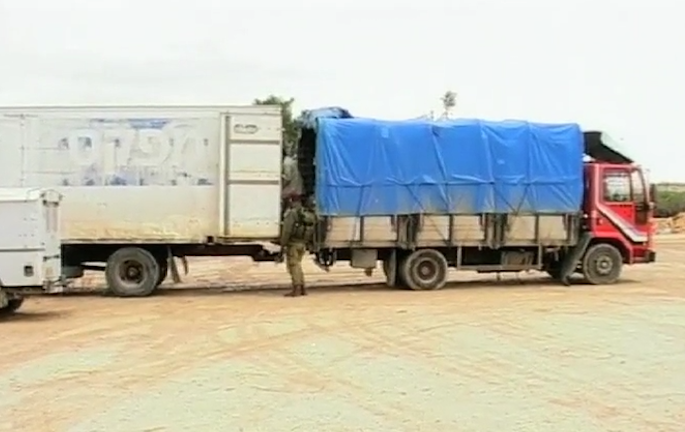“No prosperity, no development, no humanitarian crisis.” A senior official in Prime Minister Benjamin Netanyahu’s right-wing government purportedly once confided to a UN official that this was Israel’s goal for Gaza. Supressing without starving the population has been a prevalent policy of the occupation regime in Gaza, and also in the West Bank, in Jerusalem, and towards Palestinian populations within Israel.
There are no belly-blimped malnutritioned children in Palestine. There is no starvation. No hunger. And if the Israeli occupation regime has its way, there never will be. But there is also a high dependency on humanitarian assistance for foodstuffs in Palestine. And, if the occupation regime has its way, there always will be.
Ariella Azoulay’s experimental film, The Food Chain (Israel/US, 2004, 14 min.), exposes the contradiction of the Israeli occupation’s two-pronged approach: with one hand Israel strikes the blow, with the other hand it provides assistance; together, they keep Palestinians on the verge of a catastrophe but do not let them slide into all-out starvation. This is the occupation’s food chain. Amazingly, the film precedes the 2006 public debacle that came in the aftermath of an Israeli Prime Minister advisor’s statement that Israel’s policy is designed to “put the Palestinians on a diet, but not to make them die of hunger.” It is also before its time in highlighting questions of food insecurity and critiques of humanitarianism.
At a dozen minutes long, the film intersperses talking heads with scenes of burlap sacks, warehouses, trucks, and a huddled mass of women singing “there is no hunger in Palestine.” There is no mistaking that this is shot during the Second Intifada: before Israel “disengaged” from and placed a siege on Gaza, before checkpoints were transformed into unpassable border terminals, and before the publication of the “red line” document.
The Israeli Coordinator of Government Activities in the Occupied Territories–COGAT–constructed a matrix of averages to calculate the minimum caloric intake necessary for Palestinians in Gaza to survive without starving. 2,270 calories per person, apparently. Or, 170 trucks delivering foodstuffs per day. This red line document was exposed in 2009 by Israeli NGO Gisha and two Ha’aretz journalists–six years after Azoulay’s The Food Chain.
According to the officials in the film there is no humanitarian crisis. If anything, they firmly believe the opposite. The female officer does not see the irony in claiming that the two top priorities of the Israeli state are security against terrorism and humanitarian assistance, as if the two are not connected through a thread that begins and ends at the heart of the policies of the state she serves and for which she is speaking. Likewise, her colleague states with clear pride that not only are the Israeli state and army humanitarian, they’re “super humanitarian.” As such, it is not hunger that Palestinians face, but a “shortage of materials.” And if there isn’t enough of some foodstuffs permitted, flour can be pumped with iron—just enough to make sure no one dies of starvation. In fact, there is no humanitarian crisis because it is a completely man-made one. The contradictory logic of Israel’s occupation bears spelling out. Despite all facts demonstrating otherwise, Israel has claimed since the mid-1990s peace process that it is no longer “occupying” Palestinians. If Israel is not the occupying power, then it does not need to bear responsibility for Palestinians. Even though it is not responsible for the Palestinians, it concerns itself with their well-being. That’s a super humanitarian colonizer for you: it manufactures the humanitarian crisis and then proclaims to adhere to humanitarian concerns.
The title The Food Chain refers perhaps to how each being gets food and how nutrients are passed from one being to another. In Azoulay’s lens, it is also evocative of the chain of command in which only Israel permits the inflow of food commodities into Palestine. In the meantime, the UN agency charged with taking care of Palestinians and importing a majority of foodstuffs such as flour, oil, and sugar—the United Nations Relief and Works Agency (UNRWA)—is caught between providing for Palestinians and essentially subsidizing the occupation. In the words of the UN official on screen: “if we were not to give it then perhaps the Israeli government would be forced into doing so.”
The phrase food chain also refers to the material reality of dependency without starvation, which we see and hear glimpses of in the film: warehouses, sacks of flour and sugar, lists of foodstuffs not permitted or held up at the port, caloric intakes, mechanisms to slowdown and complicate the transfer of goods. Finally, the food chain is also the means by which “solutions” emerge in the face of the banality of the occupation. The most salient visuals are the scenes where we see the back-to-back method of moving goods: trucks back up against each other at a checkpoint; and while a soldier oversees the process, Palestinians unload and reload all the goods from one truck to another. This happens in a methodical and nonchalant manner, highlighting the very absurdity and everydayness of occupation.
By connecting violence, poverty, economic dependency, enclosure, and diets, The Food Chain is ultimately a glimpse into how a colonized society is refashioned to accept its subjugation by being forced to focus on survival rather than political concerns.


